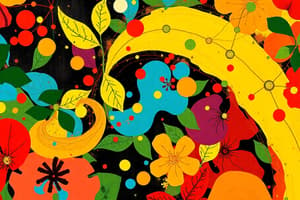Podcast
Questions and Answers
Which structural feature distinguishes flavones from flavonols?
Which structural feature distinguishes flavones from flavonols?
- Double bond between positions 2 and 3 of the C ring (correct)
- Absence of a ketone in position 4
- Presence of alkoxyl groups on the B ring
- Presence of a hydroxyl group in position 3 of the C ring
Which group of flavonoids contains compounds that have an open C ring?
Which group of flavonoids contains compounds that have an open C ring?
- Flavonols
- Chalcones (correct)
- Flavones
- Isoflavones
In which position of the C ring is the B ring linked for neoflavonoids?
In which position of the C ring is the B ring linked for neoflavonoids?
- Position 4 (correct)
- Position 5
- Position 3
- Position 2
Which of the following flavonoids is classified as a flavonol?
Which of the following flavonoids is classified as a flavonol?
What is the primary factor that leads to the diversity of flavonols?
What is the primary factor that leads to the diversity of flavonols?
What characteristic color is associated with flavonoids, as indicated by their Latin origin?
What characteristic color is associated with flavonoids, as indicated by their Latin origin?
Which components make up the structure of flavonoids?
Which components make up the structure of flavonoids?
At which position is the B-ring most commonly attached to the C-ring in flavonoids?
At which position is the B-ring most commonly attached to the C-ring in flavonoids?
Which sugar moiety can be attached to flavonoid glycosides at position 3 or 7?
Which sugar moiety can be attached to flavonoid glycosides at position 3 or 7?
What role do flavonoids play in plant growth apart from being color pigments?
What role do flavonoids play in plant growth apart from being color pigments?
Flashcards
Flavonoids
Flavonoids
A group of polyphenolic compounds found in plants.
Polyphenolic Compounds
Polyphenolic Compounds
Organic compounds containing more than one phenol group.
Secondary Metabolites
Secondary Metabolites
Compounds produced by plants that are not directly involved in growth.
Chemotaxonomic Markers
Chemotaxonomic Markers
Signup and view all the flashcards
Flavonoid Structure
Flavonoid Structure
Signup and view all the flashcards
Glycosides
Glycosides
Signup and view all the flashcards
Aglycone
Aglycone
Signup and view all the flashcards
Glycone
Glycone
Signup and view all the flashcards
Phenylpropanoid
Phenylpropanoid
Signup and view all the flashcards
Plant Defense Mechanisms
Plant Defense Mechanisms
Signup and view all the flashcards
Flavonoid Hydroxyl Groups
Flavonoid Hydroxyl Groups
Signup and view all the flashcards
Flavonoid Glycosides
Flavonoid Glycosides
Signup and view all the flashcards
Flavonoid Solubility
Flavonoid Solubility
Signup and view all the flashcards
Flavonoid Classification
Flavonoid Classification
Signup and view all the flashcards
Isoflavones
Isoflavones
Signup and view all the flashcards
Neoflavonoids
Neoflavonoids
Signup and view all the flashcards
Flavones
Flavones
Signup and view all the flashcards
Flavonols
Flavonols
Signup and view all the flashcards
Chalcones
Chalcones
Signup and view all the flashcards
Flavonoid Methylation
Flavonoid Methylation
Signup and view all the flashcards
Important Flavonoids (Examples):
Important Flavonoids (Examples):
Signup and view all the flashcards
Study Notes
Flavonoid Structure and Diversity
-
Flavones lack a hydroxyl group at position 3 of the C ring, while flavonols possess a hydroxyl group at this position.
-
Chalcones are a group of flavonoids that have an open C ring.
-
Neoflavonoids have the B ring attached to the C ring at position 8.
-
Quercetin is classified as a flavonol.
-
The diversity of flavonols stems primarily from the variety of substitutions on the A and B rings, including hydroxyl groups, methoxyl groups, and other functional groups.
-
Flavonoids are known for their yellow color due to their Latin origin, "flavus," meaning yellow.
-
Flavonoids are comprised of two phenyl rings (A and B) connected by a three-carbon unit (C ring), forming a 15-carbon skeleton with various modifications and substitutions.
Flavonoid Characteristics and Functions
-
The B-ring is most commonly attached to the C-ring at position 2 in flavonoids.
-
Glucose, a sugar moiety, can be attached to flavonoid glycosides at position 3 or 7.
-
Flavonoids contribute to plant growth, playing roles in pollination, seed dispersal, UV protection, and defense against herbivores.
Studying That Suits You
Use AI to generate personalized quizzes and flashcards to suit your learning preferences.




